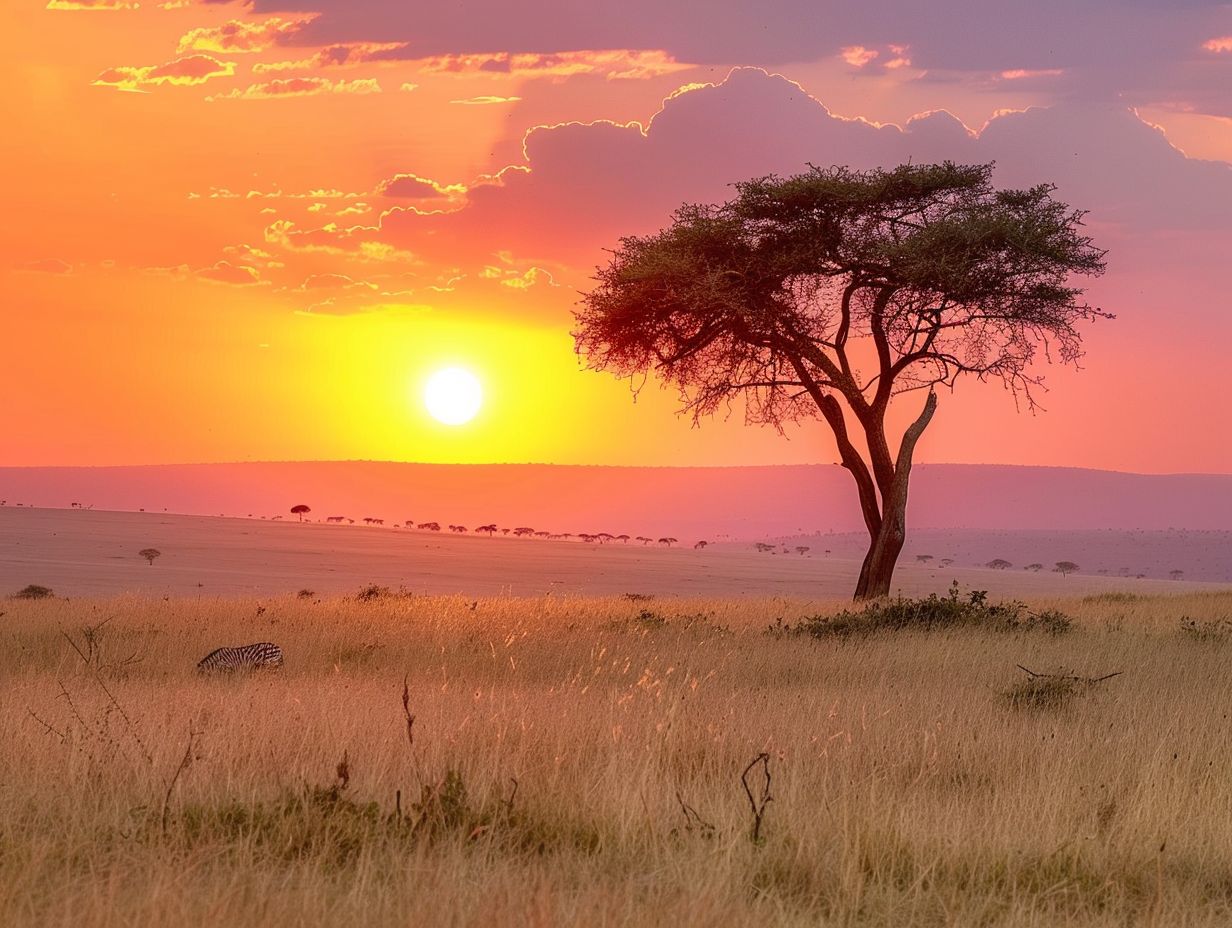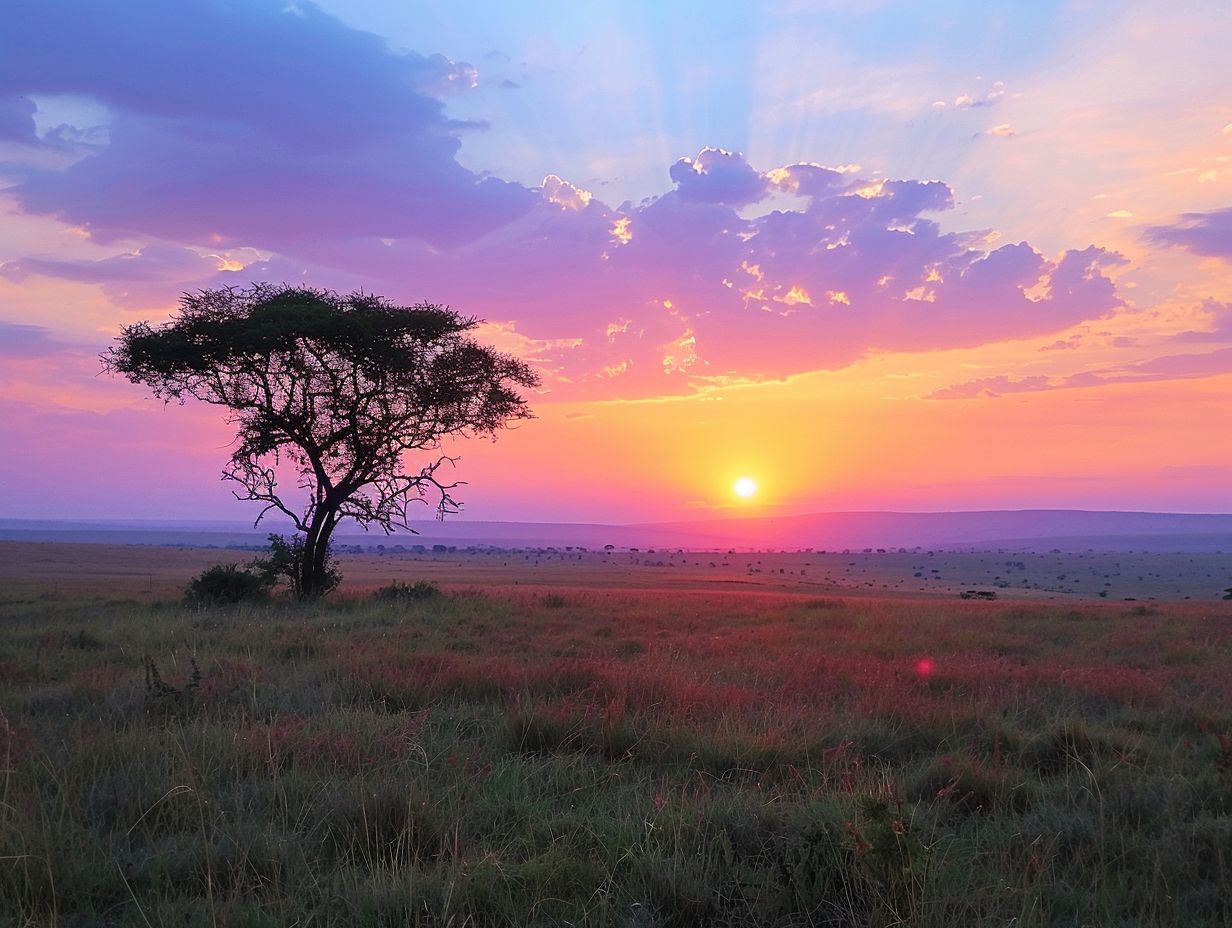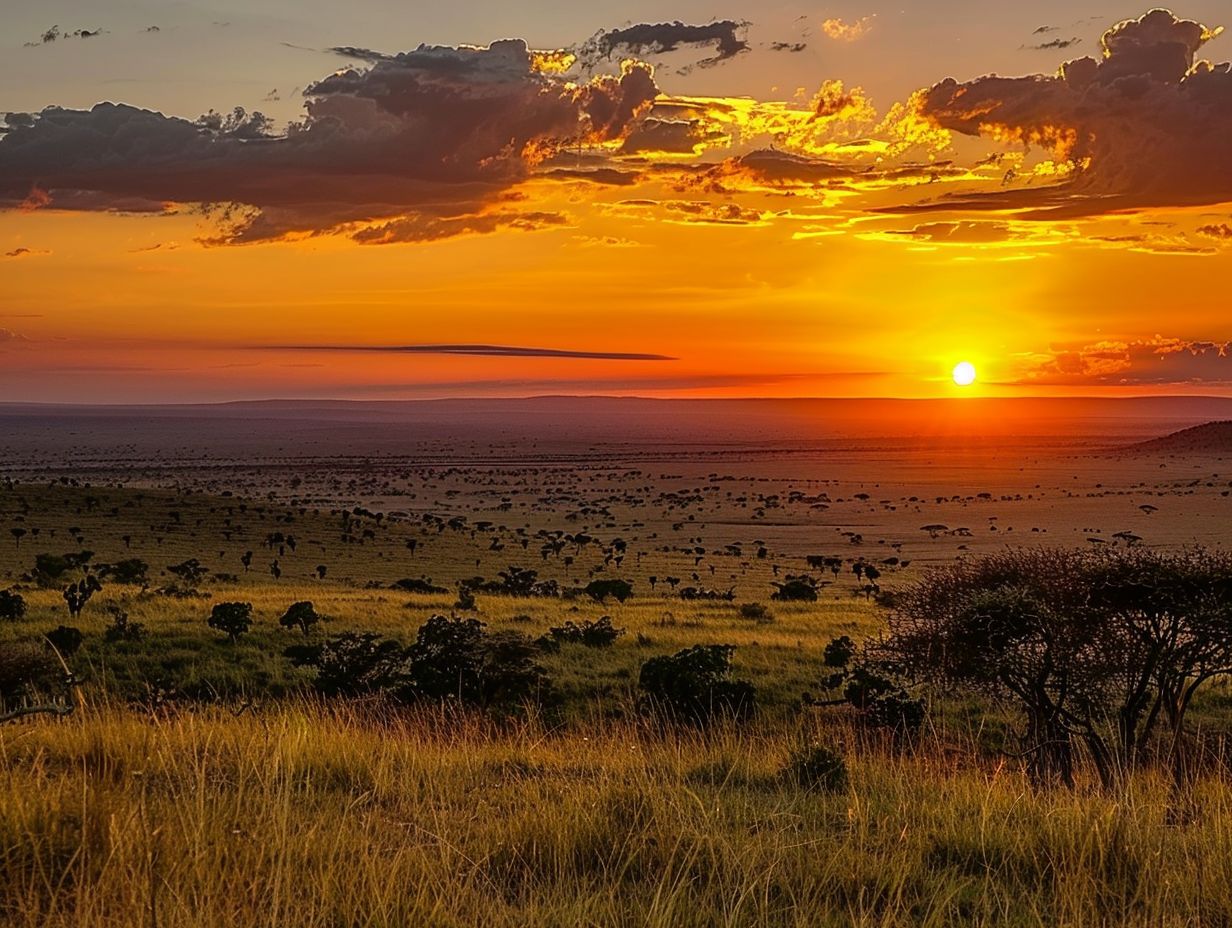
Best Time To Visit Tanzania
Planning a trip to Tanzania but unsure of the best time to visit?
We explore the factors to consider when planning your trip, including the high, low, and shoulder seasons in Tanzania.
Discover the pros and cons of visiting during each season and how the weather and climate can impact your experience, especially when it comes to wildlife viewing.
Stay tuned to make the most of your Tanzanian adventure!
Key Takeaways:

- The best time to visit Tanzania is during the dry season, which runs from June to October.
- Consider the pros and cons of visiting during high, low, and shoulder season before planning your trip to Tanzania.
- Wildlife viewing is best during the dry season, but visiting during the rainy season can offer lower prices and fewer crowds.
What is the Best Time to Visit Tanzania?
The best time to visit Tanzania depends on several factors, including the wildlife migration patterns, climatic conditions, and the type of experience you seek. Tanzania offers a unique blend of natural wonders and cultural events that can be enjoyed throughout the year.
One of Tanzania’s most iconic natural events is The Great Migration, where millions of wildebeest and zebras cross the Serengeti plains in search of greener pastures. Witnessing this spectacle is a once-in-a-lifetime experience that usually occurs between July and October.
Apart from the wildlife sightings in Serengeti National Park and Ngorongoro Crater, visitors can also immerse themselves in the vibrant local culture by attending Masai tribal festivals such as the Maasai Olympics or the cultural rituals that take place in various villages.
It’s recommended to plan your visit during the dry season which typically runs from June to October to have the best chance of spotting diverse wildlife and enjoying the multitude of cultural events that Tanzania has to offer.
Factors to Consider When Planning a Trip to Tanzania:
When planning a trip to Tanzania, it is crucial to consider factors such as the timing of the Great Migration, the weather patterns in different seasons, and the availability of wildlife sightings in various national parks and reserves.
Understanding the seasonal variations will significantly enhance your safari experience in Tanzania. For avid birdwatchers, knowing the migration patterns of various bird species can lead to remarkable sightings.
Being aware of cultural events happening during your visit can provide a deeper immersion into the local traditions and way of life, enriching your overall travel experience.
Considering all these aspects and aligning your trip with the natural rhythms of the region will not only maximize your chances of witnessing awe-inspiring wildlife moments but also allow you to appreciate the beauty and diversity of Tanzania to the fullest.
1. High Season in Tanzania:
The high season in Tanzania, characterized by abundant wildlife sightings and vibrant cultural events, is a popular time for tourists to experience the wonders of the Serengeti and other major national parks.
During this time, the Serengeti National Park becomes a hub of activity with the great wildebeest migration, where thousands of animals traverse the sweeping plains in search of fresh grazing lands.
The sight of this natural spectacle is truly awe-inspiring, drawing visitors from all corners of the globe to witness this remarkable event. The acclaimed Ngorongoro Crater showcases a breathtaking concentration of wildlife, offering unparalleled opportunities for unforgettable safari adventures in the heart of this stunning landscape.
-
What are the Months of High Season in Tanzania?
The high season in Tanzania typically falls during the dry months of June to October, when the Great Migration spectacle reaches its peak and wildlife congregates around water sources for prime viewing opportunities.
During June to October, Tanzania experiences a surge in tourists seeking to witness the awe-inspiring animal migrations. As the dry season prevails, the landscapes become more parched, compelling wildlife to gather around rivers and waterholes, creating spectacular wildlife viewing moments.
This period is ideal for those fascinated by the natural world as the clarity of the dry season makes spotting the diverse flora and fauna easier amidst the lush surroundings of the national parks.
Visitors can anticipate exhilarating safari experiences, including guided game drives, walking safaris, and hot air balloon rides, all offering unique perspectives of the mesmerizing behavior of the animals in their natural habitats.
-
What are the Pros and Cons of Visiting Tanzania During High Season?

Visiting Tanzania during the high season offers unparalleled wildlife sightings, festive events, and optimal weather conditions, but it also comes with higher prices, crowded tourist attractions, and the need for advance bookings.
One of the remarkable advantages of visiting Tanzania during the high season is the opportunity to witness the Great Migration in Serengeti National Park, where millions of wildebeest and zebra migrate in search of greener pastures.
The diverse cultural festivals, such as the Zanzibar International Film Festival, give travelers a chance to immerse themselves in the vibrant local culture and traditions.
Travelers should be prepared for the inflated costs of accommodations, tours, and activities during this peak period, and may encounter long queues at popular attractions.
2. Low Season in Tanzania:
The low season in Tanzania, though less crowded and more affordable, may offer limited wildlife sightings and unique experiences due to the wetter conditions and potential closures of some tourist facilities.
For travelers seeking a more intimate and serene safari experience, the off-peak period can be surprisingly rewarding. The lush landscapes during this time provide a picturesque backdrop for photography enthusiasts. With reduced visitor numbers, there is a greater chance of encountering elusive species in a quieter setting, creating a sense of exclusivity and authenticity.
-
What are the Months of Low Season in Tanzania?
The low season in Tanzania typically occurs during the wet months of April and May, where some lodges and parks may be closed or have limited activities due to the rainy weather.
In April and May, the rainy conditions can significantly impact tourism infrastructure in Tanzania. The heavy downpours often lead to road closures and difficult travel conditions, making it challenging for visitors to navigate the country. Wildlife viewing opportunities during this period can be limited as animals seek shelter from the rain, making them harder to spot.
Many lodges choose to close during the low season to conduct maintenance work or due to low visitor numbers. This may result in a reduction of accommodation options for travelers during this time. It is essential for tourists planning a trip to Tanzania in these months to check ahead for lodge closures and plan their itinerary accordingly.
-
What are the Pros and Cons of Visiting Tanzania During Low Season?
Traveling to Tanzania during the low season offers the advantage of reduced rates and fewer tourists, but it may involve limited wildlife sightings, increased rainfall, and potential disruptions in park accessibility.
The cost savings during the low season can be quite substantial, allowing budget travelers to experience more for less. The quieter environments enable a more serene exploration of alternative attractions that may not be as crowded, offering a more unique and personal experience.
On the other hand, the rainy season can bring its challenges, with muddy conditions making certain areas harder to access, potentially impacting outdoor activities. Despite these drawbacks, the allure of exploring Tanzania during the off-peak season can be a rewarding and memorable experience for those seeking a different perspective on this diverse destination.
3. Shoulder Season in Tanzania:
The shoulder season in Tanzania, transitioning between high and low seasons, offers a balance of moderate prices, fewer crowds, and varied wildlife opportunities, making it a favorable time for a diverse safari experience.
During this transitional period, visitors can benefit from a pleasant climate, with milder temperatures than the scorching heat of the high season, creating ideal conditions for exploring the natural wonders of Tanzania.
Flexibility is key during the shoulder season, allowing travelers to adjust their itineraries with ease and capitalize on unexpected wildlife sightings. The lesser-known attractions also shine during this time, devoid of the hustle and bustle that often characterizes peak seasons.
-
What are the Months of Shoulder Season in Tanzania?

The shoulder season in Tanzania typically occurs in November and early December, providing a transition from the high season to the low season, with moderate weather conditions and fewer tourists.
The months of November and early December in Tanzania witness a subtle shift in temperatures as the country moves from the dry season to the short rains. This period offers a unique opportunity to experience the best of both worlds – the tail end of the dry season with its clear skies and the beginnings of the rejuvenating rainfall that transforms the landscape.
During the shoulder season, visitor numbers tend to decrease compared to peak months, allowing for a more intimate and authentic safari experience. This time also marks a change in the behavior of wildlife, with animals starting to migrate towards areas with fresh vegetation brought on by the rains.
-
What are the Pros and Cons of Visiting Tanzania During Shoulder Season?
Traveling to Tanzania during the shoulder season allows for a balance of moderate prices, decent weather, and fewer crowds, yet it might involve some seasonal variability in wildlife sightings and activity availability.
One of the key benefits of visiting Tanzania during the shoulder season is the opportunity for more budget-friendly travel compared to peak times, enabling travelers to explore this diverse country without breaking the bank.
The pleasant weather during this transitional period provides comfortable conditions for safaris and outdoor adventures, with temperatures not reaching the extremes experienced in the peak of the dry or wet seasons. The reduced tourist numbers allow for a more intimate experience with nature and local culture, fostering a sense of exclusivity.
Weather and Climate in Tanzania:

The weather and climate in Tanzania vary throughout the year, influencing wildlife behavior, visitor activities, and the overall travel experience in this diverse East African destination.
During the dry season, from June to October, safari-goers can enjoy optimal game viewing as animals congregate around water sources. The clear skies and warm temperatures make it a popular time for visitors seeking wildlife encounters.
In contrast, the wet season, from November to May, brings lush vegetation, perfect for birdwatching and seeing young animals. The rains can make some areas inaccessible, affecting travel logistics and road conditions.
-
What is the Weather Like in Tanzania Throughout the Year?
Tanzania experiences diverse weather patterns, with distinct dry and wet seasons affecting different regions, wildlife movements, and visitor experiences, creating a dynamic environment for travel enthusiasts throughout the year.
During the dry season from June to October, wildlife viewing in Tanzania reaches its peak as animals congregate around water sources, making them easier to spot. This period also offers clear skies and pleasant temperatures, perfect for exploring the national parks.
Between November and May, the wet season brings lush landscapes and newborn wildlife, enhancing the natural beauty of the region, albeit with occasional heavy rainfall that can affect road conditions and accessibility to some remote areas. It is essential for travelers to pack accordingly and plan their itineraries to make the most of these seasonal variations.
-
How Does the Weather Affect Wildlife Viewing in Tanzania?
The weather conditions in Tanzania play a crucial role in wildlife viewing opportunities, as dry seasons concentrate animals around water sources, while wetter periods create lush landscapes and unique birdwatching experiences, offering diverse encounters for safari enthusiasts.
During the dry season, from June to October, the scarce rainfall forces wildlife to congregate near waterholes and rivers, providing exceptional game viewing opportunities in places like the Serengeti and Ngorongoro Crater. This period is ideal for witnessing the Great Migration spectacle of wildebeest and zebras crossing the plains.
Conversely, the wet season, spanning from November to May, transforms the landscape into a vibrant sanctuary teeming with life, making it an excellent time for birdwatching enthusiasts seeking endemic species in the lush vegetation.
Frequently Asked Questions:
1. What is the best time to visit Tanzania for a safari?
A: The best time to visit Tanzania for a safari is during the dry season, which runs from June to October. During this time, the vegetation is less dense, making it easier to spot wildlife. Additionally, animals tend to congregate around water sources, making it easier to see them.
2. What is the best time to visit Tanzania for a beach vacation?
A: The best time to visit Tanzania for a beach vacation is during the dry season, which runs from June to October. The weather is warm and sunny, and the water is clear and calm, making it perfect for swimming and other water activities.
3. When is the peak tourist season in Tanzania?
A: The peak tourist season in Tanzania is during the dry season, which runs from June to October. This is when the weather is most pleasant and wildlife viewing is at its best. However, this is also the busiest and most expensive time to visit.
4. What is the best time to avoid crowds in Tanzania?
A: If you want to avoid crowds, the best time to visit Tanzania is during the low season, which runs from April to May. During this time, there are fewer tourists, and prices for accommodations and activities are lower. However, keep in mind that this is also the rainy season, so there may be some disruptions to your plans.
5. Is Tanzania worth visiting during the rainy season?
A: Yes, Tanzania is still worth visiting during the rainy season. While the weather may not be as ideal, the landscape is lush and green, and there are fewer tourists. Additionally, some lodges and camps offer discounts during this time.
6. What is the best time to visit Tanzania for bird watching?
A: The best time to visit Tanzania for bird watching is during the rainy season, which runs from November to May. This is when migratory birds are present, and the wetlands are teeming with birdlife. However, some areas may be inaccessible due to heavy rains, so it’s best to plan accordingly.